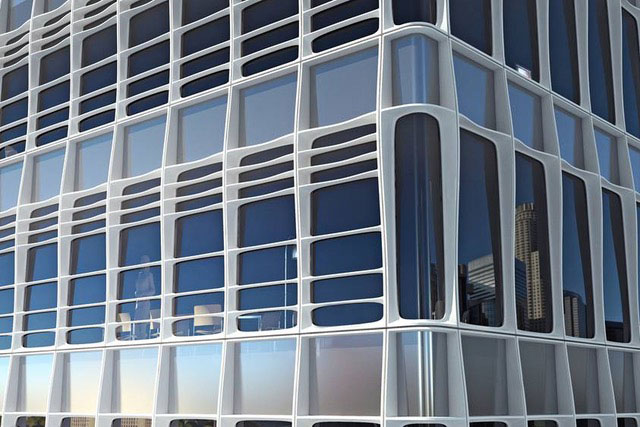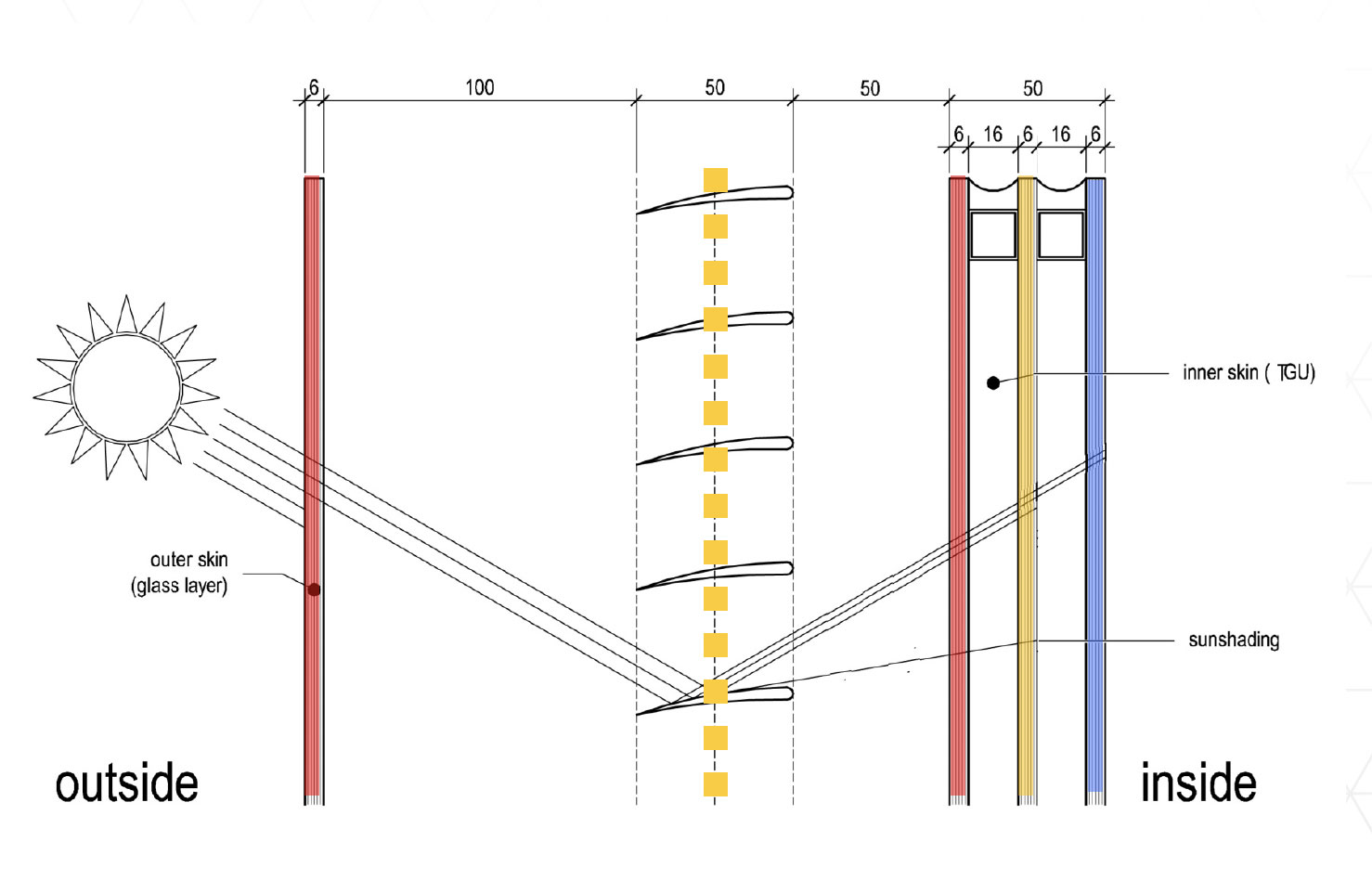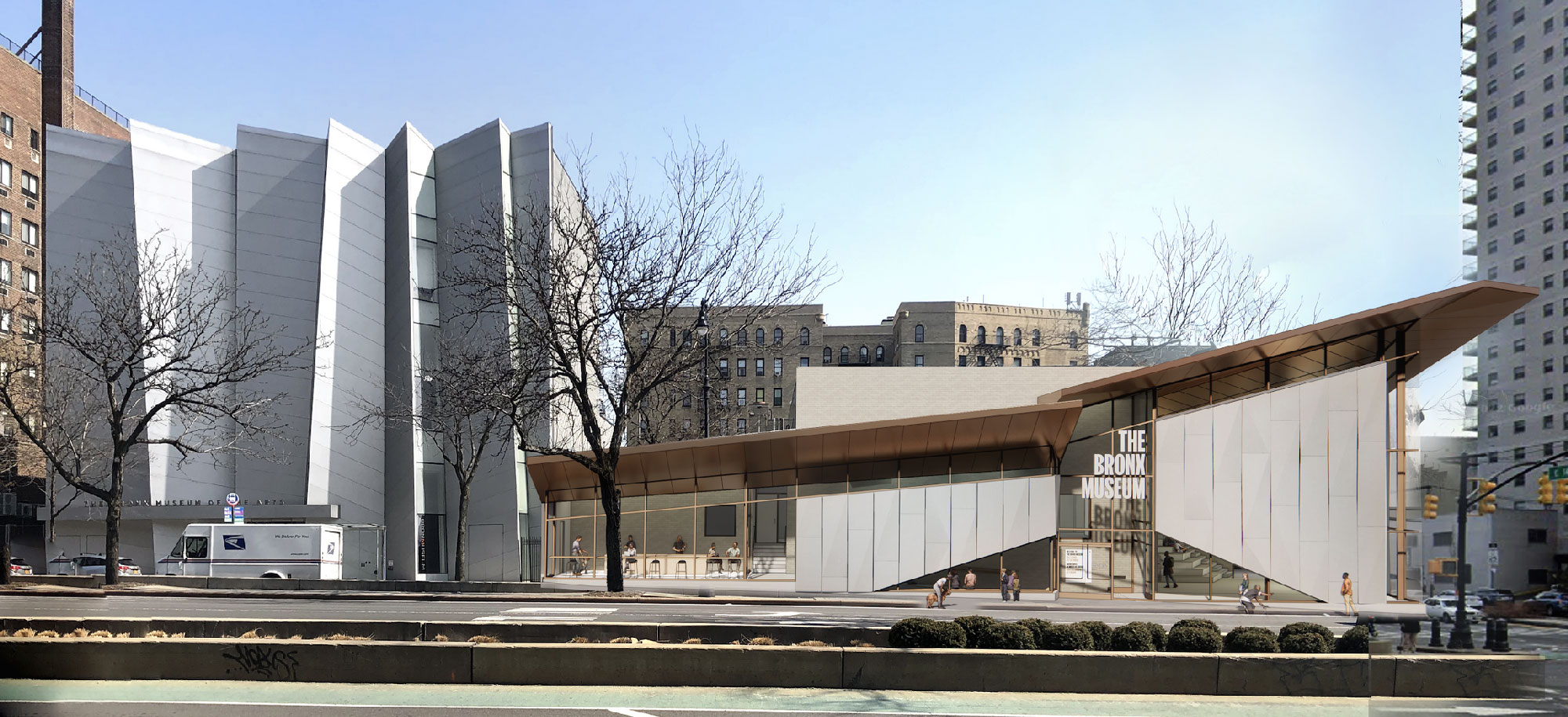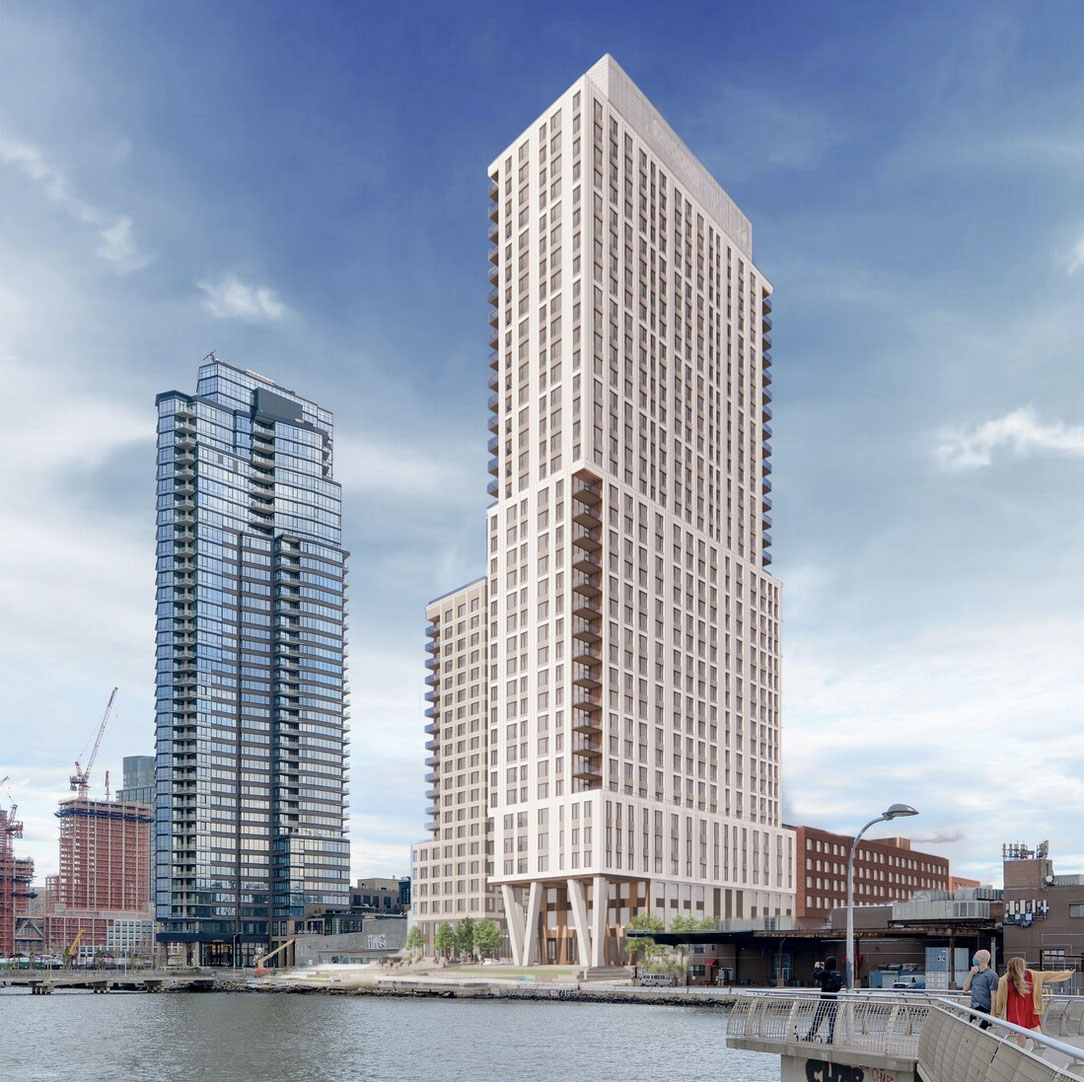Net Zero Performance and Curtain-Wall Systems
What’s Achievable Now and What’s Possible in the Future
Sponsored by The Ornamental Metal Institute of New York | Presented by William B. Millard, PhD

Photo courtesy of CBT Architects
In plans for 380 Stuart in Boston's Back Bay, careful product selection, creative design strategies, and a willingness to invest in triple glazing are setting new standards for the energy performance of curtain walls.
As a metric, a goal, a marketing instrument, a criterion within certification systems, or a buzz phrase, the term net zero can mean different things to different people. Like green, sustainable, or eco-friendly, net zero is sometimes used loosely to indicate good intentions without a rigorous foundation of greenhouse gas (GHG) emission measurement to support it. Nevertheless, through the efforts of conscientious designers and the forward-looking segments of the building-products industries, net zero and near-net-zero buildings have moved from an intention to a reality, and today’s architects are in a position to advance decarbonization by incorporating net zero standards into their designs. Curtain walls, as essential contributors to (or detractors from) a building’s energy performance, are one of the critical sites for these efforts.
Architects and builders may view net zero, or at least some claims about it, with a degree of justifiable skepticism and caution. Canadian Minister Catherine McKenna, the former chair of the United Nations’ High-Level Expert Group on the Net-Zero Emissions Commitments of Non-State Entities, said at the 27th Conference of the Parties (COP27, Sharm El-Sheikh, Egypt, 2022) that “the planet cannot afford delays, excuses, or more greenwashing,” crediting some organizations with making tangible, purposeful progress on emission reduction while charging that in other areas, “too many of the net zero pledges are... little more than empty slogans and hype” (COP27 “Zero Tolerance”).
The High-Level Expert Group, created by Secretary-General António Guterres after COP26 in Glasgow, 2021, identified several patterns of conduct by non-state actors (industry, financial institutions, cities, and regions) that compromise the value of the net zero and “net-zero-aligned” concepts. These categories of greenwashing include claims of net zero status by entities that continue to build or invest in new fossil-fuel supply; purchases of low-integrity credits; focusing on reducing emissions intensity rather than absolute emissions, or tackling part of emissions rather than the full value chain of Scopes 1, 2, and 3 (as defined by the GHG Protocol to address operational and embodied carbon, direct and indirect); lobbying to undermine governmental climate policies; and reliance on voluntary initiatives rather than regulated requirements for net zero (U.N. High-Level Expert Group, Integrity Matters, p. 7). The group’s report insists on “not only long-term pledges but also short-term science-based targets” and public reporting with verifiable, comparable information on these actors’ progress.
Yet regardless of misuse of the term and contention over its meaning, the net zero concept can guide and motivate efforts to improve buildings’ performance. Net zero at its best designates a serious commitment to managing both operational and embodied carbon, achieved through the deployment of a full range of systems and technologies, both familiar and new. Since facades account for a substantial proportion of a building’s energy use and consequent carbon footprint, optimizing the function of a curtain wall offers considerable leverage toward GHG emission reduction on the single-building scale and beyond. Net zero codes in some locations are driving impressive achievements despite the inherent challenges in the thermal properties of curtain-wall systems (see Case Studies, “380 Stuart Street”).
NET ZERO, ABSOLUTE ZERO CARBON, AND OTHER BENCHMARKS
Net zero can be seen not so much as an innovation by the architects and engineers of the developed world, comments Dennis Vermeulen, AIA, LEED BD+C, partner at Marvel in New York, but as a traditional global norm reflecting the frugal energy-use patterns of nonindustrial societies. “The skeptic in me sometimes thinks that it’s intentionally not clear,” he says, “so people can make more out of things.” He recalls a conversation early in his career, after he had been studying net-zero buildings and “crowing, ‘Oh, we’re going to do a net-zero building,’ and someone I was working with said, ‘You know, about half the world lives net zero right now.’ And I think in terms of how the term should be used, that’s actually the correct term. You don’t heat or cool your home. Your home is actually built out of local material. Maybe it’s bio-based material; it’s what you have. It’s certainly not much bigger than what you need. In the last, maybe, 20 years, that’s changed. So I think more and more people are living in cities and living in architectural environments, but to me, the correct concept of zero is really zero.”
In the developed world, there are more near-net-zero buildings, net-zero-ready buildings, and buildings that use offsets to reach a zero emission measurement than buildings that can satisfy rigorous net zero criteria. The net zero concept, to Vermeulen and other practitioners, is most useful when interpreted in a broad context. “Standardization of the terms would really be helpful,” he says. “When we look at it as design, we’re really looking at carbon footprint, so that’s everything from extraction of materials, fabrication of systems, shipping it to the site, installing it, and then building a building, and then operating a building. And even how you would dismantle a building and recycle those materials: that’s what we’d like to look at. And when we do that, of course, we’re very far away from the kind of zero carbon that we want to be. But every day, I think we get a little bit better.”
Shanta Tucker, PE, LEED AP BD+C, director at the New York office of environmental consultants Atelier Ten, credits the American Society of Heating, Refrigerating and Air-Conditioning Engineers (ASHRAE) with offering “a pretty good working definition that combines an energy-efficient building that has no fossil-fuel use with the ability to produce as much electricity locally as it uses within a year.” A net-zero building in this sense is metered and connected to the utility grid, has infrastructure that produces electricity (e.g., photovoltaics [PVs] where applicable), and may also have some purchased green power.
The U.S. Department of Energy (DOE) has incorporated the ASHRAE standard by reference in its newly published definition, requiring a building to be highly energy-efficient, free of on-site GHG emissions from energy use, and powered solely from clean energy. DOE’s fuller definition of those three criteria, the relevant report states, is a minimum standard, not a regulatory standard in itself but one to be used by public or private entities determining buildings’ zero-emission status:
- Highly energy-efficient: Buildings must demonstrate exceptional energy efficiency, placing them among the top performers in the market or achieving significant reductions in energy use compared to model codes.
- Free of on-site emissions from energy use: Zero-emissions buildings must eliminate direct GHG emissions from on-site energy consumption.
- Powered solely from clean energy: All energy used by the building must come from carbon-free sources, whether generated on-site or procured from off-site sources. (U.S. DOE, “National Definition of a Zero Emissions Building”)
The DOE definition also does not permit carbon offsets, an approach drawing frequent charges of allowing fudging by entities continuing to emit GHGs. DOE’s interpretation of a zero-energy building is based on source energy use intensity, one of multiple metrics used in the field (for an overview of ten common metrics provided by the Scottish firm Integrated Environmental Solutions, see Buckley).
Mic Patterson, PhD, LEED AP BD+C, ambassador of innovation and collaboration at the Facade Tectonics Institute (FTI), agrees with the UN group about undisciplined interpretations of net zero, associating it with other terms often used imprecisely (sustainability, regenerative architecture, etc.) in a category he calls “sustainababble.”
To use net zero purposefully, “the first thing we need to do is agree on a definition,” he says. “I don’t think we even understand what net zero is, and I know we don’t know how to achieve it. We went for a long time ignoring the embodied-carbon part of the carbon equation, and that is half of the equation. You’ve got operational carbon; you’ve got embodied carbon. We were, for decades, solving the operational problem by adding to the embodied carbon burden without quantifying that. We had just left that out of the equation entirely.” It is also possible, he suggests, that another unrecognized footprint component will require recognition: “It’s like layers of the onion, and one of the biggest, most recent layers was embodied carbon. Well, what are we going to find out next? There will be a next.”
Life cycle assessment (LCA), the only means of assessing embodied carbon, “remains at least as much an art form as it is a science,” Patterson adds, with different practitioners often providing different answers to the same problem. Another complication he mentions is that the primary tools for LCA, environmental product declarations (EPDs), are frequently entrusted to manufacturers, who hire LCA consultants, so that without independent verification, another abbreviation may plausibly be considered: COI, conflict of interest.
The gap between the intention to reduce emissions and reliable means of reaching net zero, Patterson observes, is not insurmountable. LCA tools and databases such as EC3 and Tally (see “A Number and a Story: Optimizing Design and Construction to Reduce Embodied Carbon”, Architectural Record, July 2024), he notes, are making it easier to assess embodied carbon during material selection; progress continues regardless of degrees of precision. “A lot of good designers and good firms are truly trying to figure this out and move in that direction.... It’s a great aspiration. We don’t have the tools that we need to ensure that we’re hitting it, and we don’t have the strategies or tools to do that. But to do everything we can with what we have is critical.”
Vermeulen’s colleague at Marvel, Jeremy Iannucci, AIA, LEED BD+C, suggests that “either net or neutral is the misleading word there, where it implies a balancing between the carbon or the energy and either offsets or further energy production. Absolute zero carbon is the actually aspirational goal, where you’re minimizing the carbon emissions throughout the entire process.” The discussion of balancing, he continues, “does make the goal accessible. A lot of developers are going to be in the position where buying offsets is still the correct and beneficial way to go. But I do think reduction should be the focus... not just balancing, not net, not neutral, just minimizing.”
Atelier Ten often promotes the concept of absolute zero carbon rather than net zero, recognizing the broad context surrounding performance metrics. As Tucker says, “We see the absolute zero carbon as what we’re working towards, as a tool to make a road map for our work in consulting and helping clients make decisions. So the ‘absolute’ part is recognizing that it isn’t just the building, but it’s how people get there. It’s what they do once they’re in the building. It’s the life cycle of all of the demands the building makes on the outside world: what gets delivered, what gets used and discarded? And that then really opens up the conversation about transit, about food waste, what to do with renovations, and how to make decisions about long-term retrofits, short-term retrofits. And we also like to be inclusive of all building systems for construction.” As clients and collaborators become more familiar with embodied carbon as well as operational, Tucker continues, the absolute-zero criterion targets not only the footprints of the structure and enclosure but “the lights, the wires, the metals: everything that goes into the building.” Retrofitting an existing building creates opportunities to upgrade facade materials and other components in a coordinated fashion (see Case Studies, “Bronx Museum South Wing”).
“The fact that there are multiple definitions of net zero” strikes Stephen E. Selkowitz, senior advisor for building science at Lawrence Berkeley National Laboratory, “as useful, because we can tease apart the details.” He recognizes a hierarchy of strategies: “There’s what you must do, what you should do, and what’s nice to do.” Every building must “meet or beat code,” using readily available and cost-effective means; a smaller subset of major organizations that can afford to invest in designers and technologies that attain net zero (the government included, he says) should do so; and on the vanguard of innovation, experiments with technologies for which markets are not ready, or may never be ready despite years of experimentation, remain worth exploring on a proof-of-concept basis, pushing the envelope of the possible.
Selkowitz alternates between recognizing achieved and achievable gains and expressing a degree of frustration that the facade technologies associated with them are not more widely implemented. “From a ‘what can be done?’ point of view,” he says, “we know we can make a facade net zero, or net-zero carbon, net-zero energy, whatever you want it to be. We know how to do it.” On the other hand, he wonders, “Why isn’t this business as usual?” Expense, complication, and inexperience with installation, he finds, account for slow adoption of high-performing products such as triple, quadruple, “thin triple” (with an interior lite only 0.5 to 1.6 mm thick, or even a lightweight suspended plastic film) and vacuum-insulated glazing (VIG). He has evaluated a range of high-performance window technologies for the California Energy Commission (Selkowitz 2024)—“more on the residential side, but it’s conceptually similar issues,” he comments – and finds that while long-heralded innovations like VIG and aerogel continue to face barriers not limited to cost and availability, thin triple windows occupy a promising sweet spot between technical performance and potential market acceptability, though nudges from the public sector may be necessary.
“If you look at 30 or 40 years, I’m quite optimistic that these changes could happen,” Selkowitz continues. “But if you want to solve the global problem of climate change, you need to do it in 10 to 20 years, not 30 to 40. And so the question is, ‘Can it be accelerated?’ The answer is, yes, with the right policy, and the policy and technology are two parts of the same thing.” He summarizes by defining himself as “an optimist about all this stuff generally, but when it comes to the marketplace, having been doing this for 40-plus years, I’m a pragmatist about what really works and what doesn’t,” he says.
“On the one hand,” Selkowitz says, “the purist in me, and the champion, says, ‘Let’s go all the way, and let’s do it right. Let’s define zero carbon in a way that includes both operational and embodied, and is on site, and is not buying rebates from someplace else.’ But there’s another part of me that goes back to the old saying that the perfect is the enemy of the good. In the end, what you want is to reduce total carbon; if you can get a million buildings to get halfway there versus one building to go all the way there, I argue for the million buildings.”
GETTING SKIN IN THE GAME
“The industry doesn’t seem to get that the way to net zero is right through the building skin,” Patterson says. “It’s not about the facade system being secondary and focusing on the mechanical system. You’ve got to integrate the whole building performance, and the big integrator is the facade system.” An often-overlooked point about energy-conserving facades, he finds, is that despite disparate metrics and goals, “we know a lot. Not only is there a lot of knowledge, there are even a lot of products out there to deal with these things, and they’re sitting on the shelf and not being used,” even though better-performing products often have only incrementally higher costs, or even no additional cost. Developers’ tendency to consider first cost rather than life-cycle costs, he says, is a recurrent barrier to adoption of high-performance technologies such as lightweight triple glazing, transparent PVs, nonconductive integrated-glass-unit (IGU) spacers, or polymer thermal breaks.
Codes, Patterson finds, can drive improvements, but only so far, given many developers’ view of them. “The minimum performance standards are what is represented in the building codes. It’s the way that you can legally build the worst-performing building.” Owner-developers and occupant-developers such as corporate headquarters or the General Services Administration (GSA) create “opportunities to go beyond code,” he observes, “but a lot of the building that’s gone on has been spec development by [non-occupant] developers, and you can get them to move a little beyond code so that they can raise a flag and say it’s green, or it’s got LEED credentials.”
With too little attention paid to the service life of products or buildings, Patterson continues, “We’re still selling facade systems as zero-maintenance systems” rather than planning for a level of maintenance and durability that can strengthen claims about embodied-carbon reduction. “We’re basically saying ‘You can’t maintain this; it’s good for as long as it’s good, and then you’ve got to tear it down and put a new one up.” With this short-term approach prevalent, despite the availability of durable materials and technologies, he concludes, “We have been very busy building tomorrow’s problems today.”
A facade’s contribution to a building’s energy management varies widely with its scale and form, Tucker says: slim residential buildings with a high proportion of facade area to floorplate are at the higher end of the spectrum of contribution to energy losses, while fatter buildings with large floorplates generate substantial heat on the interior while losing relatively less energy through their skin. Local climate extremes also correlate with the facade’s proportionate role: “In general, in areas that have a tighter temperature range,” she says, “your facade is going to most likely matter less, as you can design it to deal with a smaller range of conditions and be more optimized.” The facade’s contribution “could be as small as 5 to 10 percent of the energy use [or] as big as a quarter.”
From the energy modeling that Vermeulen and colleagues have performed on their projects, his estimate of curtain walls’ contribution to the emissions footprint ranges higher and implies they are a key priority. “If we’re talking about a true curtain wall, where the majority of your building is covered by a single system, that could be 80 or 90 percent of your building envelope. It’s not your roof [or other components], but it’s everything else, in which case that could have a 30 to 50 percent effect on your overall energy use in terms of heating and cooling. Even if you’re doing daylighting controls, you can actually reduce your lighting loads by using the window.”
On the embodied-carbon front over the full life cycle, Vermeulen estimates, a curtain wall may account for 5 to 7 percent of a project’s construction material, “but the materials in it are actually very carbon-intensive. Glass and aluminum are very intensive to produce, and even though we like to specify recycled aluminum, it’s actually hard to get recycled aluminum in curtain-wall profiles. There’s always a lead-time issue, and often you’re just buying it too late in the process to guarantee that you’re going to get that. So even if it’s a small percentage of your construction, it can be a pretty high part of your carbon footprint to begin with.” (Steel, he adds, being mostly recycled and more readily available, has lower carbon intensity per pound than aluminum or glass.)
The window-to-wall ratio is another key determinant of facade performance. “In New York right now,” Vermeulen says, “to meet code, you have to provide quite a bit of opaque area. So you’re either building interior walls behind the curtain wall and using spandrel glass, or you’re trying to get your curtain-wall manufacturer to give you higher-performing opaque sections, using back pans and insulation within.” A spandrel at floor plates reduces vision glass while improving envelope performance. “We look at adding insulation, particularly to opaque walls,” he continues, “and once you get to R 30, our energy models don’t show much appreciable change if you go to R 60. If you add another three, four, five inches of insulation, it really doesn’t change the energy model at that point. With glass and curtain-wall systems, you’re never going to get much more than R 4 or R 5 for the vision areas.”
In curtain walls as traditionally understood, Vermeulen says—“aluminum profiles capturing glass, clipped onto a building”—the glazing generally outperforms the profiles. “Even just double-insulated glass performs much better, just as an assembly on its own, than the aluminum framework does. So we think ‘slender profiles, big pieces of glass.’ The bigger the glass and the less aluminum you see, the better.” These systems with typical R ratings of 4 or 5, he says, are acceptable under New York City code only when manufacturers provide lab tests indicating better performance, “so we end up jumping through a lot of hoops to make buildings pass energy code.” Adding insulated walls is more complicated than popping in premanufactured panels, involving multiple trades, and “adding insulation inboard that’s not engineered in a system tends to move the dew point around, which can cause problems with condensation....We would love to see curtain-wall manufacturers look at more ways to engineer integral, opaque portions of their system” to attain higher R values. “The rule of thumb now is that you want your vision glazing in a building to be something like 40 percent of your facade, and you see curtain walls, particularly in commercial buildings, that are basically 90 percent vision glass. And we see products like that get permitted. I’m not quite sure how they do that with the code, because you just can’t get that kind of performance, even with triple glazing.”
One pathway to better insulation performance is use of alternative materials, which may involve tradeoffs between operational and embodied carbon. A Marvel project designed with net zero in mind, the One Java complex on the waterfront of Greenpoint, Brooklyn, uses a precast concrete curtain wall wrapping two towers (see Case Studies, “One Java”), though Vermeulen and colleagues recognize that precast “is not a very good material for embodied carbon.” The panels also require “somebody to go outboard and put a bead of sealant between them; there’s not a good gasketing and integral drainage system in it. So curtain wall is a great starting point, but it could do much more.” The firm has also experimented with terra cotta, a lighter, lower-carbon-intensity material, as a curtain-wall insert, deciding on that project (Brooklyn’s Bedford Union Armory) to use a metal panel system.
The need for better envelope performance is measurable both in carbon emissions and in financial terms, notes Peter Arbour, RA, Assoc. AIA, former principal at Socotec’s Vidaris and now founder of Arbour Group, a facade casting firm. “We’re familiar with the statistics,” he says: “40 percent of global carbon emissions come from buildings; in large cities like New York, the share increases to 70 percent.... The United States loses $30 billion a year in heating and cooling energy lost through the building envelope due to poor insulation. This is energy-ratepayer money that literally goes out the window.” In addition, he notes, the periodic failure and replacement of structurally glazed aluminum facades—“glass that’s warrantied for 10 years and will fail within 25 years, structurally glued onto the outside of the building facade framing”—predictably disrupts building operations and urban life. There is a pressing need, he and others contend, for facade systems that perform better in emissions metrics (ideally net zero or close) and have a substantially longer service life.
A promising newcomer among materials is Arbour’s Liquid Wall (see Figure 1), highlighted in a Curtain Wall Innovation competition and exhibition at the New York AIA chapter’s Center for Architecture in 2010-2011 and more recently awarded a grant for manufacturing support by the New York State tech incubator FuzeHub. Liquid Wall replaces aluminum in curtain-wall systems with a composite material, ultra-high-performance concrete (UHPC), in precast form with noncorrosive fiberglass polymer and steel-fiber reinforcement to constrain crack propagation under load. Liquid Wall units set replaceable double-glazed panels into the UHPC frame, which is cast with digitally manufactured formwork of polyurethane or silicone; the unit is 100 percent thermally broken, with nonconductive connectors and a polymer thermal break separating the exterior and interior. The material’s plasticity is conducive to design precision and fine tolerances: “My material supplier at the moment cast a vinyl negative of a record in UHPC, a record that he could play on a record player,” Arbour reports. “It didn’t sound great, but it would play. That’s the level of finesse in terms of achieving ornamental detailing.” “UHPC is not the concrete that we see all around us,” Arbour points out; “UHPC in the Liquid Wall uses 85 percent less cement than concrete, far less than any green concrete in the market, [and] produces 75 percent less embodied carbon than aluminum facades, because it eliminates the strip mining, smelting, and global transport associated with aluminum production.” Different UHPC products use fiberglass, polypropylene, or steel fibers for reinforcement. “The secret to UHPC is the size of the aggregate,” so where you would have sand or stone or something else, which is bonded by the cement, in this case you have aggregate components that are smaller than the cement particles. So it’s usually a quartz flour and silica fume that are powders that have a particle-packing density that makes the material impervious to anything....The limits of water and chloride infiltration into the material are fractions of a millimeter versus standard concretes, where you get up to 5 mm per year.”
“The technical definition,” Arbour notes with reference to federal and state highway-authority standards, “is a concrete with a compressive strength higher than 17,000 psi,” with a typical tensile strength of 2,000-4,000 psi depending on density. Given UHPC’s strength, ductility, and flexural capacity, he says, “if you were to compare a Liquid Wall panel with a precast concrete panel, we need about 15 percent of the material to achieve the same r esult. As compared to standard concrete, we have an 85 percent lower carbon footprint, because in a standard concrete panel, you need five or six inches of high-strength concrete with rebar. If you want to insulate that panel, you’re going to a 12- or a 15-inch-thick panel with two wythes of concrete.”

Photo courtesy of Arbour Group LLC
Figure 1. Rendering of a facade using the Liquid Wall UHPC curtain-wall system.
The Liquid Wall prototype used in the Center for Architecture project was Lafarge Concrete’s Ductal, which Arbour notes was “the sole source of this type of material for many years”; there are now multiple forms of architectural UHPC available, including (but not limited to) Steelike, Taktl, Bekaert’s Dramix, Hi-Con’s CRC i2, and Cor-Tuf, “the commercialized version of the material that was developed by the Army Corps of Engineers.” Noting that “in facades, UHPC has been used as a decorative material, primarily,” rather than a complete building envelope, he sees it increasingly finding infrastructural applications thanks to its high density, waterproof and noncorrosiveness: water utility systems, replacement jointing in bridge decks, decking overlay projects in roads and bridges, and others.
The Liquid Wall framing system can incorporate energy-harvesting components such as fluid-based passive solar or transparent PVs. With Liquid Wall panels installed through the same procedures as unitized aluminum curtain wall, Arbour expects that ease of construction will combine with its thermal metrics and the material’s configurability to make it an attractive option for building owners seeking long-range facade performance. “If, by using UHPC instead of aluminum and installing the Liquid Wall,” he says, “you’re reducing your energy consumption in your building by, say, 35 percent, by the time you make that improvement down the road, you’re going to get yourself to net zero or better.”
TAKE IT TO THE BRIDGE
Thermal bridging in glass curtain walls is a persistent yet preventable problem. “The less metal you see, in some ways, the more efficient the curtain wall is,” says Vermeulen, noting that thermal breaks built into aluminum profiles “perform much better, and they’re increasing the insulation properties of curtain walls.” The glass industry has responded to decades’ worth of thermal concerns with numerous effective technologies (low-emissivity coatings, frits, multiple glazing, gas or vacuum insulation, and others), yet thermal transmission where glass meets metal is the next frontier. “We’re doing just about as much as we can do with the glass,” Patterson notes, “but the frames are a problem. They can represent 15 percent or more of the facade area.”
Thermal-break technologies are currently a subject of intensive research and development, Patterson observes, calling attention to his FTI colleague Stéphane Hoffman’s work developing guidelines for their use (Morrison Hershfield 2021) and applying the Thermal Energy Demand Intensity (TEDI) metric, which “loops the facade system into the equation” and addresses design features affecting a building’s overall heating or cooling demand more specifically than Energy Use Intensity (EUI). TEDI, defined as the summation of space and ventilation heating output divided by modeled floor area and reported in kWh per square meter per year, is used in Canada, Massachusetts, and other areas as a component of code-compliance pathways.
Thermal breaks made of polymer with fiber reinforcement (fiberglass, carbon, aromatic polyamide, or other materials) can reduce thermal bridging substantially and improve comfort for users near the curtain wall, though the use of these products in the U.S. is not yet widespread. Value engineering in the narrowest penny-pinching sense, Patterson has found, is often the culprit. “The architect will spec full thermal breaks,” he says, “aggressive thermal breaks. And the project will go to bid, and the facade contractor or the general contractor or both of them will approach the owner and say, ‘Hey, we can drop this price by 10, 12, 15 percent if we go to a thermally improved system as opposed to a thermally broken system. They’ll dumb it down.” Plastic thermal breaks are also reportedly hard to fabricate or install, drawing resistance from some contractors.
Another strategy Patterson finds promising is simply increasing the ratio of glass to thermally bridging materials, using megapanel systems larger than the typical 4-by-8-foot or 5-by-10-foot dimensions of a unitized curtain-wall panel. “You still have the issue of the performance of the frame,” he says, “but it becomes less a part of the whole surface area, and that bigger union can be highly insulated, and they’ll use punch windows. It’s much easier to change punch windows over time; as you get better technology and the existing products degrade over time, you can change out a punch window pretty easily compared to a whole unit of a facade system.” Systems that embed inexpensive networked sensors in the panels, tracking performance, any problems such as breakage or intrusion, and (for operable windows) the number of times opened and closed, signaling support teams if maintenance is required, are under development by Schüco, connecting the facade to the building management system much as an organism’s skin communicates with its nervous system.
APPROPRIATE LEVELS OF TECH
Perhaps the lowest-hanging fruit is retrofitting buildings to replace single-pane glass, which Selkowitz says accounts for about 40 percent of the glass in U.S. buildings. “Most of the glass that’s in place now will still be in place 20-30 years from now,” he says. “Unless we take some action, a good chunk of it will still be single-glazed, and if it’s single-glazed, it almost certainly is going to be a big energy and carbon problem, and comfort as well.” Triple glazing is code in Europe, and Selkowitz, after extensive research on the available and developing options (see Figure 2), finds that the “thin triple” variant, minimizing the additional weight (and embodied carbon) that leads some specifiers to opt for double instead, has much to recommend it for adoption here.

Source: Selkowitz 2024; courtesy of Stephen Selkowitz
Figure 2. Families of highly insulating glazing options, with center-of-glass thermal performance ranges: current, emerging, and future markets.
Opinions on this choice vary. “Triple glazing is a great option for a lot of retrofits [and] new projects,” comments Tucker, “but there have been some recent questions about triple glazing, as the double-glazing units have almost caught up closely with some of the film technologies to the triple glazing. The net effect is that because you only have two pieces of glass, it’s a lighter curtain wall; therefore you need less backup and structure to hold it up, and when you’re taking into consideration the whole embodied carbon story, you need less material brought on site.”
The less weight the third layer adds, the stronger the case for triple glazing. While advanced insulation approaches yielding impressive R values (in the 15-20 range) still have drawbacks other than cost–Selkowitz cites optical issues with aerogel and VIG (haze and visible spacers, respectively)–the R values around 10 with triple and 15 with quad strike him as a worthwhile improvement. In addition, “on the VIG, if you’re using a high-temperature furnace to seal the edges, you’ve got an energy input into the process. It’s not in the glass, but it’s embodied in the manufacturing unit.” Discrepancies between center and edge-of-glass performance can also cast doubt on claims of high R values. “The reality is, first of all, that the actual window numbers are going to be much lower, unfortunately, because of all the framing edge effects. So if you get the R 20 at no extra cost, that’s great, but if you’re paying a lot more to get the R 20, and then you’re degrading it at the frame, you haven’t optimized the window product; you’ve optimized the glazing.” Considering the practical context of these choices, Selkowitz says, “My argument is that the R 10 to 15 triple/quad is good enough for essentially any application you can conceivably think of.”
Windows are commonly replaced at roughly 50-year intervals (compared with 10 to 15 for lighting systems or 25 for HVAC), Selkowitz says, and their lasting effect on building performance implies a need for aggressive increases in the facade retrofit rate, he says, perhaps an order of magnitude or more. DOE has announced a competition for secondary glazing systems to address this need (US DOE, “DOE launches $2 million prize”). “They’re trying to put a niche in the market that hasn’t seen a lot of action, is most cost-effective, and if done well can have really positive impacts,” he says. Winners of the first phase, in which companies submit concepts, will be announced imminently; the second phase is prototype development, and the third will include installation in a building.
Although secondary glazing (“essentially storm windows for commercial buildings”) has received less attention than heat pumps as a decarbonization strategy, Selkowitz points out synergies between them: “If you’ve got a heat pump in a building with single glazing, first of all, it’s going to be much larger than it needs to be, which means more expensive. Secondly, it’s going to have a greater demand on the grid, because the peak heating is going to be 5 or 6 am on a cold winter morning, and even if you have PV out there, it’s not going to be working at five in the morning. So our argument is that if you want to decarbonize, and you want to go to electric heat pumps, the first thing to do in every one of those buildings is make sure that that glazing is replaced. And here’s where that secondary glazing comes in, because it will typically not be cost-effective to pull out all the windows and replace them.” Some products are already available for interior retrofits, including stretch plastics, rigid plastics, or a fiberglass frame around thin glass.
Building-integrated PVs (BIPVs), a perennial hopeful among energy-optimizing facade technologies, strike Selkowitz as promising in the abstract and practical only for specific circumstances and scales. On the positive side, the cost of generating PV power has dropped dramatically in the past decade and is now below that of fossil-fuel sources. Positioning and orientation of panels, however, remain suboptimal on vertical facade surfaces, though better on rooftops or in large-scale field systems that enjoy economies of scale. BIPVs also need AC/DC conversion (since PVs produce direct current) and battery storage. “There are specific buildings and applications where it makes a lot of sense,” he summarizes, “but as a general, mainstream, large-scale solution for most buildings, I don’t see it.... Motorized shades, electrochromics, and BIPV all have the challenge of integration of power, wiring, controls, sensors, with the rest of the building.”
Another variable affecting the range of smart-window systems is system interoperability or the lack of it, Selkowitz says. “There’s a group at Lawrence Berkeley Labs that’s working on an automated facade-control package that in theory would simplify the problems so that any manufacturer of the operating hardware could tie into the software; that software would tie into the rest of the building. But every company wants their own.... If every company that made smart glazing and automated shading were all part of the same team or group, and they had a standard way of integrating all that into building HVAC, the world would be a lot simpler.” The HVAC realm’s BACnet protocol offers one model for coordinating the various smart-glass systems, he suggests, implying that the facade marketplace might follow the precedents of industries that have overcome similar issues, e.g., 19th-century railroad track-gauge standardization. “In this particular case, the guys at Berkeley are working on the underlying techy stuff. I don’t know that anyone’s trying to get into the market side of it and actually see if you can get those guys in the same room together.”
Shading is another well-recognized, frequently low-tech strategy for incremental control of heat gain or emissivity (see Case Studies, “Malibu High School”). Not all shading systems, however, are equivalent. Stephan Schütz, executive partner at Gerkan Marg and Partners (GMP), points out that “what we face a lot in the U.S. is a single layer with a double- or triple-glazing facade, then an inner sun-shading layer,” which has the disadvantage of admitting some heat into a building, though it reduces light and shadow, improving comfort more than thermal performance. A double-skin facade with an outer single layer and inner double or triple layer, plus a screen or louvers for shading in between and natural ventilation from outside (sometimes with a double floor cavity), Schütz says, is a more effective German technology invented in the 1990s, “a very good example for a building envelope.”
From GMP’s work in Beijing, where air pollution was a serious problem, Schütz continues, the firm developed a closed variant it calls the climate active facade (see Figure 3), inverting the position of the layers so that the double or triple glazing is on the outer facade, ventilation occurs from the inside, and exhaust air is drawn through the cavity. “You use, in summertime, the relatively cold air of the interior space to get sucked into the system,” he says, “and then it’s warming up when it’s going up to the ducts. So you need air-conditioned ducts along the facade, and the advantage is that the inner glazing is much colder than the outer glazing, so the comfort for people working in the building is much higher. The same effect occurs in wintertime,” with relatively warm interior air entering the cavity to warm the inner layer. The double layer saves energy, and the high degree of glazing saves electricity on lighting. American colleagues at SOM, KPF, and other firms, Schütz says, use this technology; GMP’s CYTS Plaza tower in Beijing (2006) was the first climate-active facade in China.
A fourth variant (Figure 4), the closed-cavity facade, has a completely closed and unventilated cavity, providing a high degree of insulation and integrating the shading system in the cavity, protecting the operating mechanism; this system allows nearly zero exchange of heat and cuts cleaning costs roughly in half. “It’s a quite expensive solution,” Schütz notes, relying on prefabrication; “we always try to avoid the installation of the facade on site, like the classical mullion-transom facade [often seen] in the U.S.” These units can be installed from inside, requiring no scaffolding.

Image courtesy of Gerkan, Marg and Partners
Figure 3. Climate active facade.

Image courtesy of Gerkan, Marg and Partners
Figure 4. Closed-cavity facade.
On the China State Construction Engineering Corporation (CSCEC) headquarters in Guangzhou, Schütz says, GMP and the German climate engineers Transsolar Energietechnik combined the mechanical system and the facade system, integrating 6,100 square meters of PV panels into aluminum exterior louvers to harvest approximately 600 megawatts of electricity per hour, “roughly a quarter of the energy needed in the building.” A building-high solar chimney integrated into the structure provides large-scale ventilation; office windows are automatically opened at night to create the shaft effect. Two zones (28 stories) of the 37-story building are mechanically ventilated, necessary only from June to September or October each year, saving about 400 megawatts per hour per year; the nine-story top zone is completely naturally ventilated by the chimney effect. The building is constructed but not yet in use, he says, so the energy metrics are based on simulations, but if post-occupancy measurements match the models, it will reduce carbon by 58.9 percent and overall energy by 61 percent, earning a description as “a nearly zero-energy building” by the China Association for Building Energy Efficiency (CABEE) as well as a LEED Gold rating and a three-star (top) rating in China’s equivalent Green Building Evaluation Standard.
CONCLUSION
The shift from fossil fuels to renewables in recent years has been substantial and steady; as of this writing, the U.S. Energy Information Administration has reported that over the first seven months of calendar year 2024, wind and solar systems generated more electricity than coal for the first time in history (US EIA, July 2024). Ensuring that this encouraging pattern is irreversible, commentators agree, is well within reach. Regulatory measures like New York City’s Local Law 97, California’s Title 24, and Massachusetts’s Stretch Energy Code are driving performance upgrades on all fronts, providing incentives in areas where technical specialists have long perceived market failures. Facades are a building component with enormous potential for practical improvement, either reaching a true net zero standard or making substantive emission reductions in that direction.
GMP’s Schütz, discussing German systems for reusing building components deconstructed and recycled from adaptive-reuse projects (citing the “circular construction” firm Concular in particular), observes philosophical differences between European and North American practices. “We see buildings as material storage,” he says; “this is the idea of cradle to cradle,” guiding efforts to keep track of materials and their roles in orderly processes, relegating the “throwaway mentality,” not the materials, to the scrap heap.
Tucker likewise notes that Atelier Ten admires European architects’ “attitude for starting with the facade, making it a fabric-first approach on the design,” recognizing the envelope’s power to determine overall performance. “The quality of some of the European facade systems and glazing are really inspiring U.S. projects to look at things like Passive House design.... We have a lot of projects that use the Passive House standard as a guide and as a goal, [and] less that have gone through the full certification”; they avoid the cost of the formal process but pursue the metrics anyway, as “they would rather get the low utility bills than the label on the outside of the building.” The same can be said of net zero: the phrase, whatever it variously means to different parties, is less important than the ways it drives decisions toward the essential goal of decarbonization.
WORKS CITED
Buckley L. Ten key building energy metrics. Integrated Environmental Solutions, n.d. https://www.iesve.com/discoveries/view/3812/ten-key-building-energy-metrics.
COP27: ‘Zero tolerance for greenwashing’, Guterres says as new report cracks down on empty net-zero pledges. UN News, Nov. 8, 2022. https://news.un.org/en/story/2022/11/1130317.
Lawrence Berkeley National Lab. High performance windows: thermal and optical performance of residential and commercial windows (2024, May 30). https://windows.lbl.gov/high-performance-windows.
Morrison Hershfield, Ltd. Building Envelope Thermal Bridging Guide. Version 1.6. Vancouver: BC Hydro Power Smart, 2021. https://www.bchydro.com/content/dam/BCHydro/customer-portal/documents/power-smart/builders-developers/building-envelope-thermal-bridging-guide-v1-6.pdf.
Selkowitz, Stephen. State-of-the-Art Review of High-Performance Window Technologies. Report to California Energy Commission, Energy Research and Development Division, May 2024 [draft]; final version forthcoming.
United Nations’ High-Level Expert Group on the Net Zero Emissions Commitments of Non-State Entities. Integrity Matters: Net Zero Commitments by Businesses, Financial Institutions, Cities and Regions. United Nations, 2022. https://www.un.org/sites/un2.un.org/files/high-level_expert_group_n7b.pdf.
U.S. Department of Energy, Office of Energy Efficiency and Renewable Energy. DOE launches $2 million prize to advance cost-effective, energy-efficient commercial windows. February 14, 2024. https://www.energy.gov/eere/articles/doe-launches-2-million-prize-advance-cost-effective-energy-efficient-commercial.
U.S. Department of Energy. National Definition of a Zero Emissions Building. March 6, 2024. https://www.energy.gov/eere/buildings/national-definition-zero-emissions-building.
U.S. Department of Energy, Office of Energy Efficiency and Renewable Energy. National Definition of a Zero Emissions Building. Part 1: Operational Emissions from Energy Use, Version 1, June 2024. https://www.energy.gov/sites/default/files/2024-06/bto-national-definition-060524.pdf.
U.S. Energy Information Administration. Monthly Energy Review, July 2024. DOE/EIA-0035(2024/7). https://www.eia.gov/totalenergy/data/monthly/pdf/mer.pdf.
Bill Millard is a New York-based journalist who has contributed to Architectural Record, The Architect's Newspaper, Oculus, Architect, Annals of Emergency Medicine, OMA's Content, and other publications.
The Ornamental Metal Institute of New York is a not-for-profit association created to advance the interests of the architectural, ornamental, and miscellaneous metal industries by helping architects, engineers, developers, and construction managers transform designs into reality.
Originally published in Architectural Record
Originally published in September 2024
LEARNING OBJECTIVES
- Define fundamental terms such as net-zero energy, net-zero carbon, absolute zero carbon, and carbon neutrality, and demonstrate familiarity with applications of these concepts as defined by U.S. and international organizations.
- Recognize the range of available curtain-wall systems that contribute to a building’s performance, including widely available products, advanced or aspirational technologies, and traditional or low-technology approaches.
- Recognize several recent and contemporary construction projects that have achieved or approximated net-zero carbon metrics through high-performing curtain-wall systems and complementary approaches.
- Understand the long-range environmental effects of designing and building with the range of facade technologies, placing the contribution of curtain walls in the context of a building’s overall performance.


















